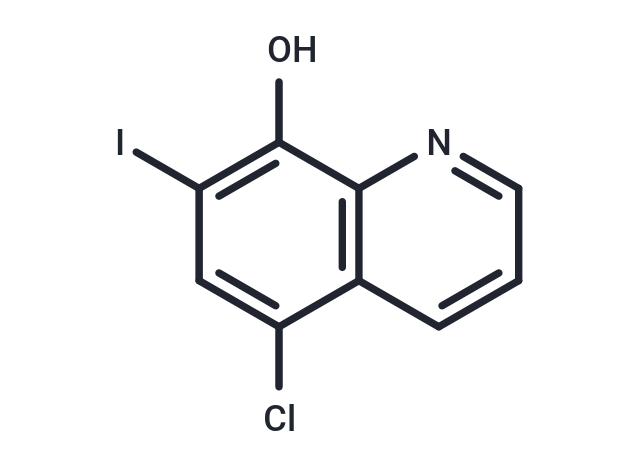Shopping Cart
- Remove All
 Your shopping cart is currently empty
Your shopping cart is currently empty

Clioquinol (Iodochlorhydroxyquin) is an orally bioavailable, lipophilic, copper-binding, halogenated 8-hydroxyquinoline with antifungal, antiparasitic and potential antitumor activities.

| Pack Size | Price | Availability | Quantity |
|---|---|---|---|
| 200 mg | $31 | In Stock | |
| 500 mg | $46 | In Stock | |
| 1 g | $53 | In Stock | |
| 5 g | $98 | In Stock | |
| 1 mL x 10 mM (in DMSO) | $48 | In Stock |
| Description | Clioquinol (Iodochlorhydroxyquin) is an orally bioavailable, lipophilic, copper-binding, halogenated 8-hydroxyquinoline with antifungal, antiparasitic and potential antitumor activities. |
| Cell Research | DU 145 cells are plated in a 12-well plate. After incubation for 24 h, the cells are treated with 10 μM clioquinol and 50 μM ZnCl2 for 2 h. AO is then added to each well (at a final concentration of 2.5 μg/ml). After 30 min of incubation with AO, cells are washed twice with HBSS and examined with a fluorescence microscope. (Only for Reference) |
| Alias | Iodochlorhydroxyquin, Chinoform |
| Molecular Weight | 305.5 |
| Formula | C9H5ClINO |
| Cas No. | 130-26-7 |
| Smiles | OC1=C(I)C=C(Cl)C2=C1N=CC=C2 |
| Relative Density. | 1.8959 g/cm3 (Estimated) |
| Storage | Powder: -20°C for 3 years | In solvent: -80°C for 1 year | Shipping with blue ice. | ||||||||||||||||||||||||||||||||||||||||
| Solubility Information | H2O: < 1 mg/mL (insoluble or slightly soluble) Ethanol: 1 mg/mL (3.27 mM), Sonication is recommended. DMSO: 55 mg/mL (180.03 mM), Sonication is recommended. | ||||||||||||||||||||||||||||||||||||||||
Solution Preparation Table | |||||||||||||||||||||||||||||||||||||||||
Ethanol/DMSO
DMSO
| |||||||||||||||||||||||||||||||||||||||||

Copyright © 2015-2025 TargetMol Chemicals Inc. All Rights Reserved.